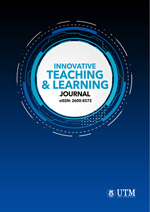Flipped Classroom in Secondary School or High School Education: A Review of Its Advantages and Challenges
DOI:
https://doi.org/10.11113/itlj.v6.81Keywords:
Blended learning; flipped classroom; secondary school; advantages, challengesAbstract
Advanced technology in education provides various facilities to enhance students’ learning. The evolution of technology has become an integral part of sustaining life, especially in education. The technology in education develops and continues its development with innovative learning approaches to sustain the needs of the 21st-century learning environment. The transformation in the educational field takes out the existence of a new strategy that is flipped classroom learning approach. A flipped classroom is a learning approach that is a type of blended learning that involves face-to-face and online learning instruction. The flipped classroom is a pedagogical approach in which learning activities that have traditionally taken place inside the classroom occur outside the classroom and vice versa. Flipped classroom provides an interactive learning environment where teachers guide students as they engage actively in the subject matter. Thus, this paper will review the recent literature regarding the potential of flipped classroom technology in education and explore its advantages and challenges. The review describes the potential of the flipped classroom in various fields of education, including Chemistry, Physics, Mathematics, Biology, and Civics at secondary school or high school level. Searching of the literature was obtained from several databases by using certain Boolean queries when searching the keywords. Ten papers were selected according to the specific criteria. This paper concludes the advantages and challenges during the implementation of FC. The advantages of flipped classsroom are increased students’ motivation during learning processes, providing active learning, increasing learning perception, increasing learning engagement, enhancing knowledge, increasing teacher-student interaction, increasing peer interaction, enhancing creativity and helping to improve students’ achievement and performance. The challenges of FC are the time-consuming for teachers to prepare the learning materials, lack of teachers’ technical skills to produce learning videos, lack of students’ motivation to watch the pre-class video, and the difficulty of students to understand the contents presented in the learning video. Based on these challenges, this paper provides the literature recommendations that can help to produce effective flipped classroom environments in the future.

















